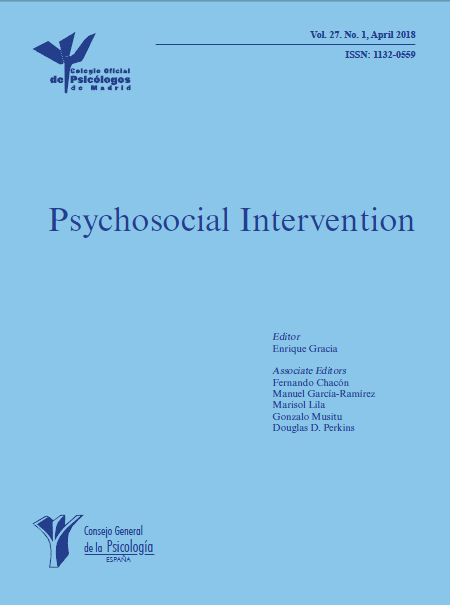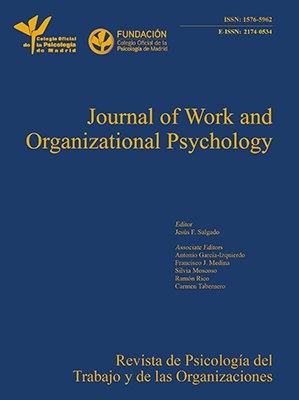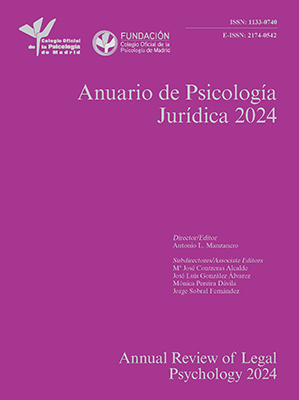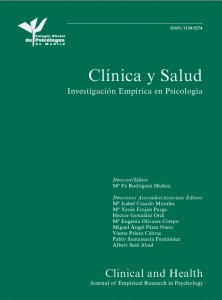
Emotional and Behavioural Symptoms in Adolescents: Age, Sex, and Psychosocial Risk
[Los sĂntomas emocionales y conductuales en los adolescentes: la edad, el sexo y el riesgo psicosocial]
Álvaro Rodríguez-Mora1, 2, Pilar Fornell1, 3, Yolanda Sánchez-Sandoval1, and 3
1Departamento de PsicologĂa, Universidad de Cádiz, Spain; 2Instituto Universitario de InvestigaciĂłn para el Desarrollo Social Sostenible (INDESS), Cádiz, Spain; 3Instituto de InvestigaciĂłn e InnovaciĂłn BiomĂ©dica de Cádiz (INiBICA), Spain
https://doi.org/10.5093/psed2025a2
Received 27 February 2024, Accepted 25 June 2024
Abstract
The aim of this study was to analyse the presence of emotional and behavioural difficulties in adolescents and their relationship with personal (age and sex) and contextual (level of psychosocial risk) variables. The sample consisted of 802 participants (48.6% girls, 51.4% boys) aged between 9 and 16 years (M = 11.97, SD = 1.40). The Strengths and Difficulties Questionnaire (SDQ) and the Psychosocial Risk Index were used. Significant differences were found as a function of sex, age and risk level. The presence of problems increased with age and under more adverse psychosocial conditions. The behavioural symptoms were more frequent in the boys, and the emotional symptoms and prosocial behaviours were more frequent in the girls. The regression analyses confirmed the predictive capacity of these variables. These results have implications for the understanding of mental health difficulties in adolescence, and they guide in the prevention for this population group.
Resumen
El objetivo de este estudio ha sido analizar la presencia de dificultades emocionales y conductuales en adolescentes y su relación con variables personales (edad y sexo) y contextuales (nivel de riesgo psicosocial). La muestra la componían 802 participantes (48.6% chicas, 51.4% chicos) en edades comprendidas entre los 9 y los 16 años (M = 11.97, DT = 1.40). Se utilizó el Cuestionario de Fortalezas y Dificultades (SDQ) y el Índice de Riesgo Psicosocial. Se encontraron diferencias significativas en función del sexo, la edad y el nivel de riesgo. La presencia de problemas aumentó con la edad y en condiciones psicosociales más adversas. Los síntomas conductuales fueron más frecuentes en los chicos y los emocionales y las conductas prosociales en las chicas. Los análisis de regresión confirmaron la capacidad predictiva de estas variables. Estos resultados tienen implicaciones a la hora de entender las dificultades de salud mental en la adolescencia y orientan la prevención en este grupo poblacional.
Palabras clave
SDQ, Adolescente, SĂntomas emocionales, SĂntomas conductuales, Riesgo psicosocialKeywords
SDQ, Adolescent, Emotional symptoms, Behavioural symptoms, Psychosocial riskCite this article as: Rodríguez-Mora, Á., Fornell, P., & Sánchez-Sandoval, Y. (2025). Emotional and Behavioural Symptoms in Adolescents: Age, Sex, and Psychosocial Risk. PsicologĂa Educativa, 31(1), 11 - 18. https://doi.org/10.5093/psed2025a2
Correspondence: yolanda.sanchez@uca.es (Y. Sánchez-Sandoval).Mental healthcare during childhood and adolescence is key for the adequate development of the young population. Professionals in this scope have become increasingly interested in the last decades due to the fact that mental health problems pose developmental deficiencies with relevant implications for individual wellbeing (Patalay & Fitzsimons, 2018), as well as for daily and social functioning (Ortuño-Sierra et al., 2016). Specifically, emotional difficulties and behavioural problems increase the demand for social, educational, healthcare, and law services (K. Baker, 2013). The prevalence of these problems has increased in the last years. Although a large percentage of children and adolescents do not present symptoms that match the clinical criteria, emotional difficulties and behavioural problems cause great suffering among them. Fonseca-Pedrero et al. (2011, p. 17) proposed that “studying the prevalence rate of emotional-behavioural symptoms provides a better understanding of child-youth psychopathology and allows improving the public healthcare systems in terms of early detection and prevention, treatment and resource management.” Specifically, it is estimated that 8.7-22.6% of children and adolescents present emotional problems, and 2.4-14.6% show behavioural problems (Ortuño-Sierra et al., 2014). More recently, according to the last survey on child mental health conducted in Spain in 2017, 13.2% of children and adolescents aged 4-14 years were at risk of presenting emotional and behavioural problems, with those aged 4-9 years obtaining the highest percentage (14.2%). Regarding sex, this risk was greater in boys (15.6%) than in girls (10.5%). Similarly, there was an increased risk in the most disadvantaged social classes, reporting 16.2% in risk areas (Ministerio de Sanidad [Ministry of Health], 2020). Moreover, emotional and behavioural difficulties have been associated with low life satisfaction (Reinholdt-Dunne et al., 2011) and poor self-perceived quality of life (Stevanovic, 2013). On the contrary, the development of prosocial behaviours in childhood and adolescence has been related to lower behavioural problems (Gutman et al., 2019; Nantel-Vivier et al., 2014), for instance, when entering school and during the transition to adolescence (Flouri & Sarmadi, 2016). Following the said authors, these prosocial behaviours could be acting as a protective factor against the development of behavioural problems. Therefore, detecting the variables involved in the difficulties of psychological adjustment at the emotional and behavioural level, as well as the presence of prosocial behaviours, is key for said development (Dahlbeck & Lightsey, 2008; Ortuño-Sierra et al., 2016; Schoeps et al., 2019), since mental health problems that appear during childhood and adolescence may persist up to adulthood, or even predict future problems in later stages (Spaan et al., 2023). In this sense, it is critical to know which internal and contextual variables of the subject may be significantly related to the psychological adjustment of children and adolescents. Individual Variables and Emotional and Behavioural Difficulties Most studies show the influence of individual variables, such as sex and age, on the presence of emotional difficulties and behavioural problems in childhood and adolescence (Fonseca-Pedrero et al., 2011; Ortuño-Sierra et al., 2016; Ortuño-Sierra et al., 2014; Ortuño-Sierra et al., 2022; Schoeps et al., 2019). Regarding sex, emotional difficulties and behavioural problems are different between women and men. The literature demonstrates that girls present more internalising problems, whereas boys show more externalising problems (K. Baker, 2013; Hoffmann et al., 2020; Vugteveen et al., 2022). More specifically, boys get higher scores in behavioural problems, problems with classmates, and hyperactivity (Liu et al., 2013; Tobia et al., 2013; Yao et al., 2009). On their part, girls obtain higher scores in emotional problems (Di Riso et al., 2010; Ortuño-Sierra et al., 2016; Reinholdt-Dunne et al., 2011; Rønning et al., 2004). With regard to prosocial behaviours, studies agree that women present greater scores than men (Di Riso et al., 2010; Giannakopoulos et al., 2009; Liu et al., 2013; Ortuño-Sierra et al., 2016; Ortuño-Sierra et al., 2022; Pulido Guerrero et al., 2022; Tobia et al., 2013). In terms of trajectory, these studies determine that during childhood boys tend to show more behavioural problems and hyperactivity than girls up to adolescence. Then, during adolescence, the proportion of girls presenting said difficulties increases considerably, with boys and girls obtaining similar scores in this aspect. In girls, emotional problems increase with age (Giannakopoulos et al., 2009). Regarding age, the literature does not show conclusive results when comparing age groups. Several studies have reported an increase of mental health problems with increasing age. These studies state that older groups (14-18 years) present higher mean scores in emotional, behavioural, and hyperactivity symptoms compared to younger groups (Crick & Zahn-Waxler, 2003; Fonseca-Pedrero et al., 2011; Ortuño-Sierra et al., 2014; Yao et al., 2009). In the same vein, Giannakopoulos et al. (2009) reported that the group of adolescents aged 15-17 years obtained higher scores in hyperactivity and behavioural problems compared to the 11-14 year group. On their part, Rønning et al. (2004), in a sample of boys and girls aged 11-16 years, found that the girls, who obtained greater levels of emotional symptoms, increased their scores in higher educational stages. However, boys showed higher levels of externalising problems in all educational stages. On the contrary, other studies show that the scores in emotional and behavioural problems decrease academic levels progress (Di Riso et al., 2010; Liu et al., 2013). Externalising behaviours, such as hyperactivity, are more frequent in early stages, with internalising behaviours being more frequent in adolescence (Arman et al., 2012). Nevertheless, these conclusions are usually associated not only with age but also with sex. Several studies have analysed the differences between age groups and gender. For instance, Van Roy et al. (2006) determined that behavioural problems were more prevalent in the 13-16 year age group for both sexes. On the other hand, emotional problems increased with age in girls, while presenting the greatest prevalence at 10-13 years in boys. The scores in hyperactivity were higher after these ages, remaining stable in the 13-19 year age range. The scores of problems with classmates decreased with age in girls and later in boys. From the teachers’ view, primary education students show greater emotional and behavioural difficulties than secondary education students. In turn, prosocial behaviours also obtain higher scores in primary education students (Tobia et al., 2013). With regard to prosocial behaviours and their relationship with age, the literature shows an increase between early and intermediate adolescence, followed by a slight decrease. This development of prosocial behaviours would be influenced by sex, beginning earlier in girls, based on the theory of gender role intensification (Luengo Kanacri et al., 2013; Van der Graaff et al., 2018). Contextual Variables and Emotional and Behavioural Difficulties The concept of socioeconomic status refers to the social and economic resources of a person or group compared to other persons or groups in the same social system. There are generally a wide variety of socioeconomic indicators, with the most commonly used being economic income, education level, and professional prestige (E. H. Baker, 2014). These indicators seem to be significantly related to greater levels of behavioural problems and difficulties in childhood and adolescence (Di Riso et al., 2010). In addition to the mentioned indicators, different studies have determined the best predictors of greater mental health problems in this population. Low family income, low parental education level, single-parent families, unemployment, poor social support, bad relationship with the parents, and parental mental health problems are associated with greater mental health risk in childhood and adolescence (Davis et al., 2010; Ravens-Sieberer et al., 2008), as well as with a decrease of health-related quality of life (Von Rueden et al., 2006). The systematic review conducted by Reiss (2013) determined a clear relationship between a low socioeconomic status and mental health problems. In adolescents, high family income predicts better health-related quality of life (Von Rueden et al., 2006). In this line, adolescents’ perception of low family income would act as a predictor of emotional problems (Reinholdt-Dunne et al., 2011). Boys and girls, especially those aged 9-17 years, from families with low socioeconomic status have significantly greater possibilities of presenting mental health problems compared to their peers from families with medium and high socioeconomic status (Klipker et al., 2018). Likewise, different studies have concluded that the effects of socioeconomic disadvantages in early ages remained constant up to the beginning of adolescence, which reflects the importance of the risks that may be present during childhood (Gutman et al., 2019). The contexts of development in childhood also predict the evolution of mental health. There is a greater tendency toward experiencing internalising and externalising mental health problems in a more unfavourable social environment (Sundquist et al., 2015). More specifically, living in an unfavourable social context increases the probabilities of suffering from anxiety/depression, hyperactivity, and behavioural problems compared to more favourable contexts (Butler et al., 2012). Longitudinal studies have determined that this relationship tends to remain constant in time up to adolescence (Christensen et al., 2017), demonstrating the influence of social developmental contexts on the mental health of this population (da Gama & Negreiros, 2023). In relation to prosocial behaviours, studies conclude that high levels of prosocial behaviours are related to low levels of difficulties, regardless of the social context. Therefore, an unfavourable social context does not seem to influence the presence of greater behavioural problems on boys and girls with high prosocial behaviours (Flouri & Sarmadi, 2016). According to these authors, unfavourable social contexts seem to increase behavioural problems in boys and girls with low prosocial behaviours. A significant relationship has been found between prosocial behaviour and greater internalising and externalising problems in disadvantaged neighbourhoods. In this line, these conclusions would help to accurately identify the individuals and contexts that would be a priority target for intervention (Caprara et al., 2014). Thus, socioeconomic markers are very important in childhood for the prevention of problems in adolescence. In this respect, “an early prevention of mental health problems could be focused on strengthening social competence and preventing social regression” (Reinholdt-Dunne et al., 2011, p. 161). As preventive measures for mental health problems in childhood and adolescence, studies suggest addressing low family income and strengthening social support. In view of the analysed studies, it is necessary to confirm the individual and contextual variables that influence both the presence of behavioural problems and difficulties and the development of prosocial attitudes. Therefore, the approach presented in this paper aims to analyse how gender differences and age groups can be determinants in the presence of this problem. Likewise, studies suggest that not only the intrinsic variables of the subject are related to psychological adjustment. For this reason, the aim of our study was to detect the contextual variables involved, since, according to the literature, variables such as unfavourable environments characterised by low income and low social support seem to be predictive of this maladjustment. Therefore, the analysis of the influence of these specific variables will also help to implement detection and prevention programmes in education centres in order to prevent and intervene emotional and behavioural problems in the child-youth population. Therefore, during the first years of school life, it seems convenient to carry out interventions that reduce emotional and behavioural problems, mainly when said problems are identified for the first time (Gutman et al., 2019). For this reason, it is recommended to develop psychosocial risk indices that determine the individual and socioeconomic factors related to emotional and behavioural problems in childhood and adolescence. Objectives and Hypotheses The general aim of this study was to analyse the behavioural problems of children and adolescents associated with individual variables, such as age and sex, and contextual variables, such as the different psychosocial risk environments. Additionally, this work aimed to cover the limitations of other studies by including younger ages (preadolescents and adolescents). The specific objectives were: 1) to analyse the differences in emotional and behavioural problems as a function of sex and age and 2) to explore the existence of significant correlations between emotional and behavioural problems as a function of the psychosocial risk context. In relation to the objectives set, the following hypotheses were posed: 1) emotional and behavioural problems differ as a function of sex; boys are expected to present greater scores in behavioural problems and problems with classmates, whereas girls are expected to score higher in emotional problems; 2) the frequency of emotional and behavioural problems increases with age, with older children presenting greater emotional and behavioural problems than younger children; 3) participants from risk contexts are expected to show greater emotional and behavioural problems; the social context is expected to be related to prosocial behaviours. Participants The sample consisted of 802 participants, of whom 390 (48.6%) were girls, and 412 (51.4%) were boys. The age of the participants ranged between 9 and 16 years (M = 11.97, SD = 1.40). They attended Year 6 (20%) and Year 7 (23.7%) in primary school, and Year 8 (29.1%) and Year 9 (27.3%) in compulsory secondary education (CSE). A non-probabilistic convenience sampling was carried out (Otzen & Manterola, 2017), selecting boys and girls schooled in three areas of different social risk. Gender and school year variables, χ2(802) = .820, p = .66, were adjusted to show similar distributions in the total number of participants from each area. The first group of participants consisted of boys and girls from educational centres of the Comuna de Quilpué (Chile), with a School Vulnerability Index (SVI) > 85% (n = 244, 30.4%). The second group consisted of boys and girls from educational centres located in areas of social transformation (ERACIS areas) of the region of Andalusia (Spain). According to their definition, these areas present the following indices of social risk: urbanistic deterioration; deficit of public infrastructure, equipment and services; high indices of absenteeism and school failure; high unemployment rates, along with severe professional training deficiencies; significant hygiene-sanitary deficits; and events of social disintegration (Junta de Andalucía, 2018), as well as educational centres classified as compensatory (n = 273, 34%). The third group consisted of participants schooled in educational centres of the region of Andalusia, Spain that are not included in areas of social transformation or classified as compensatory centres (n = 284, 35.4%). All students of the selected classrooms participated in the study after receiving the informed consent of their parents, and completing all the questionnaires. According to the missing-value analysis, 37 (4.6 %) participants had at least one missing value in SDQ. The MCAR test was used to assess whether the missing values were due to chance. To impute data, the regression method and the EM procedure were used. The assumption of missing at random (MAR) was confirmed (p > .05). A multiple imputation was conducted on the dataset. Specifically, an imputation was generated for SDQ, recovering 33 participants. Four participants could not be recovered. Instruments An ad hoc questionnaire was used to measure the sociodemographic variables of the sample, and it was completed by the parents or guardians of the participants. From the information gathered in the sociodemographic questionnaire for the parents, a socio-family risk index (SFRI) was created (0-9 range). The variables that made up this index were: family structure (RI1) (0 = two-parent, 0.5 = shared custody/foster family, 1 = single-parent/foster residence); maternal education level (RI2) (0 = university degree, 0.5 = non-university degree, 1 = compulsory education); economic income (RI3) (0 ≥ €1900, 0.5 = €950-1900, 1 ≤ €950); being from a different country, ethnicity or culture (RI4) (0 = no, 1 = yes); important economic needs (RI5) (0 = absence, 1 = presence); limiting diseases or dependency (RI6) (0 = absence, 1 = presence); drug addiction (RI7) (0 = absence, 1 = presence); having a family member in prison (RI8) (0 = absence, 1 = presence); and being schooled in ERASCIS areas or in schools with SVI > 80 (RI9). The score for each individual was obtained from the sum of these new indicators in each case. It is considered that the sum of cumulative risk indicators is more relevant than any factor on its own (Evans et al., 2013). This type of score has been previously used to calculate a cumulative socio-family risk index (Gutman et al., 2019; Rodríguez Rodríguez & Guzmán Rosquete, 2019; Sánchez-Sandoval & Verdugo, 2021). Higher scores indicate greater risk. Additionally, from the score in this cumulative risk index, three risk groups were created: low risk (0 to 25% of scores), medium risk (26 to 75% of scores), and high risk (76 to 100% of scores). The Strengths and Difficulties Questionnaires (SDQ) (Goodman, 1997) is an instrument that screens for emotional and behavioural difficulties and prosocial behaviours in children and adolescents. It consists of 25 items, which are scored in a 3-point Likert scale of 0 to 2 points. It consists of 5 dimensions or subscales (emotional symptoms, behavioural problems, hyperactivity, problems with classmates and prosocial behaviours). Its Spanish version (Ortuño-Sierra et al., 2015) presents good psychometric properties, with an acceptable reliability (α = .75). In this study, it presented a good internal consistency, with a Cronbach’s alpha of .72 and McDonald’s omega of .72. Procedure The project was approved by the Ethics Committee of Biomedical Research of Andalusia (Spain) (code PEIBA 2152-N-21; registration number 191.21) and the Scientific Ethics Committee of the University of Playa Ancha (CEC UPLA) of Chile (minute No 003-2020). This study was also approved by the regional educational administration, the heads of the educational centres, and the parents and guardians of the participants. The heads of the schools were first contacted to inform them about the project and request their participation in this study. In those schools that agreed to participate, the authors distributed envelopes with a letter presenting the research, the sociodemographic questionnaire for parents and tutors, and the informed consent form. The evaluation instruments were administered to those children and adolescents who brought the documents signed by their parents during school hours that did not interrupt their academic activity. Two members of the research team were in charge of visiting the schools and carrying out the evaluations. Data Analysis The data were coded and analysed using statistical software SPSS v21. Through a descriptive analysis, means, standard deviations, and percentages of the different variables were obtained. Pearson’s bivariate correlation analyses were conducted to explore the correlations among the study variables. Chi-squared, Student’s t and ANOVA tests were carried out with the aim of analysing the differences by sex and age group, respectively. Some regression analysis models were performed. Strengths and difficulties and their subscales were included as dependent variables, and the following were included as independent variables of the model: sociodemographic variables (sex and age) and contextual variables (socio-family risk index, SFRI). The assumptions were verified for the application of each statistical test. Strengths, Difficulties, and Sociodemographic Variables Regarding sex, significant differences were found in three dimensions of SDQ. In terms of emotional symptoms, t(802) = 4.231, p < .01, girls obtained higher scores (Table 1). The effect size of these differences was moderate (d = 0.30). On the other hand, boys presented higher scores in behavioural problems, t(802) = -3.114, p < .01. The effect size of these differences was small (d = 0.22). Lastly, girls showed the highest scores in prosocial behaviours, t(802) = 4.390, p < .01. The effect size of these differences was moderate (d = 0.31). As can be observed in Table 2, age was positively and significantly related to total problems (r = .167, p < .01) and to each of the problems (emotional symptoms, r = .138, p < .01; behavioural problems, r = .142, p < .01; hyperactivity, r = .097, p < .01; and problems with classmates, r = .114, p < .01). The older the age of the participants, the greater the problems they presented. Prosocial behaviours was negatively and significantly correlated with age (r = -.186, p < .01). Therefore, the older the age of the participants, the lower their prosocial behaviours. SFRI was positively and significantly related to total problems (r = .242, p < .01) and to each of the problems (emotional symptoms, r = .82, p < .05; behavioural problems, r = .236, p < .01; hyperactivity, r = .153, p < .01; and problems with classmates, r = .270, p < .01). Thus, the greater the risk, the greater the problems presented by the participants. On the contrary, prosocial behaviours was negatively and significantly correlated with risk (r = -.324, p < .01). That is, the greater the risk, the lower the prosocial behaviours shown by the participants. Strengths, Difficulties, and Contextual Variables With regard to the presence of strengths and difficulties among these preadolescents and adolescents as a function of their risk level, a one-factor ANOVA was performed with its corresponding post hoc Bonferroni analysis (Table 3). Differences were found among the three groups, with significant differences and a small effect size in all domains, except in emotional symptoms. The students of the groups of higher risk presented greater moderate scores in all of the problems. Regarding prosocial behaviours, those with a higher SFRI presented lower scores, with a moderate effect size. Predictive Capacity of the Sociodemographic and Contextual Variables over Strengths and Difficulties Several multiple linear regression analyses were conducted after verifying the multivariate assumptions in each of the subscales, using the stepwise method. The data presented an absence of collinearity. Table 4 shows the variables that were included in each of the resulting regression models. All the linear regression models calculated were significant (Table 4). As is shown by the regression values, the slopes of the total problems, hyperactivity and problems with classmates increased with increasing age and SFRI. The slope of emotional problems also increased with age and was positive with the female sex. The regression equation with respect to behavioural problems was also positive and increased with the increasing age of the boys and increasing SFRI. Lastly, in relation to prosocial behaviours, the slope of the equation was negative and decreased with the increasing age of the boys and increasing SFRI. The aim of this study was to analyse the relationship of individual variables, such as sex and age, and contextual variables, such as psychosocial risk level, with behavioural problems in preadolescents and adolescents. To this end, this work presents, as a novelty, the elaboration of SFRI as a predictor of behavioural problems. Behavioural and emotional problems were evaluated, as well as prosocial behaviours, in preadolescents and adolescents from three areas with different psychosocial risk levels. Regarding the first hypothesis, which questions whether emotional and behavioural problems differ as a function of sex, the results obtained in this study are in line with those of previous research, which show significant differences between sexes in terms of externalising and internalising problems (K. Baker, 2013; Hoffmann et al., 2020; Vugteveen et al., 2022). Thus, boys and girls are different in their levels of psychosocial adjustment. More specifically, the boys obtained greater scores in behavioural problems compared to the girls, who showed greater scores in emotional problems (Kremer et al., 2015; Ortuño-Sierra et al., 2014; Ortuño-Sierra et al., 2022; Yao et al., 2009). The literature in this regard concludes that a worse behavioural adjustment in boys increases the risk of developing behavioural problems, such as aggressiveness or delinquency (Donahue et al., 2014). On the other hand, the presence of internalising problems in girls may lead to greater emotional imbalance, which could increase the probabilities of presenting future mood alterations, such as fear or excessive worrying in general (Ordóñez et al., 2015; Schoeps et al., 2019), and disorders such as anxiety and depression in particular (Ravens-Sieberer et al., 2008). Similarly, these types of problems, both behavioural and emotional, would be related to a worse self-perceived quality of life (Stevanovic, 2013) or lower future expectations (Verdugo & Sánchez-Sandoval, 2022) in these youths. Regarding the second hypothesis, analysing the differences in terms of age in the presence of emotional and behavioural problems, the results showed an increasing amount of these with increasing age, which is in agreement with the literature. More specifically, total problems, hyperactivity, and problems with classmates increased with increasing age. Likewise, emotional problems tended to increase in the older girls, coinciding with previous studies (Ortuño-Sierra et al., 2022). In this line, other researchers conclude that preadolescents present better emotional and behavioural adjustment than adolescents (Ansary et al., 2017; Fonseca-Pedrero et al., 2011; Ortuño-Sierra et al., 2014; Yao et al., 2009). The literature shows low stability in behavioural and emotional adjustment during the transition from preadolescence to adolescence. This difference between ages may be due to the fact that adolescents have a greater cognitive development, which predicts worse self-reports about their psychological adjustment compared to preadolescents (Patalay & Fitzsimons, 2018). However, studies are not conclusive in this respect, since several studies have determined that externalising behavioural problems are more frequent at younger ages (Di Riso et al., 2010; Liu et al., 2013), such as hyperactivity, whose highest frequency is observed in preadolescents (Arman et al., 2012). It is important to highlight that these studies are based on reports made by parents and teachers, and that this discrepancy is due to the significant differences in the perception of behaviours between boys and girls and their parents and teachers (Hoffmann et al., 2020). Furthermore, with the increasing age of the participants, prosocial behaviours tended to decrease. These results are surprising, as the adolescents were expected to present greater prosocial behaviours than the preadolescents. This could be explained by the fact that, although cooperation behaviours increase with increasing age, there is also a decrease in the support behaviours (Malti et al., 2016). Moreover, a greater awareness of the adolescent about her/his strengths and limitations, which implies more complex responses, could explain the decrease of said prosocial behaviours in older youths (Rodríguez-Fernández et al., 2016). Lastly, with regard to the third hypothesis, based on the analyses performed, boys and girls from risk contexts are expected to present greater emotional and behavioural problems, as well as lower prosocial behaviours. The results showed that the SFRI developed for this work was positively and significantly related to emotional and behavioural problems. Similarly, this index was negatively and significantly related to the dimension of prosocial behaviours. More specifically, it was determined that a greater risk index would predict a greater presence of total problems, behavioural problems, problems with classmates, and hyperactivity. On the other hand, a greater risk index would predict a lower presence of prosocial behaviours. Therefore, these results suggest that the psychosocial factors established in the SFRI contribute to the increase of probabilities in boys and girls to have more behavioural and emotional difficulties, consequently presenting a greater behavioural and psychosocial imbalance. In this line, different studies have drawn similar conclusions with respect to the different factors contemplated in the elaboration of the SFRI. Contextual variables such as low socioeconomic level, low parental education level, low family income, single-parent families, unemployment, and living in a disadvantaged social context (E. H. Baker, 2014; Davis et al., 2010; Gutman et al., 2019; Ravens-Sieberer et al., 2008) act as predictors of behavioural problems and difficulties in childhood and adolescence (Di Riso et al., 2010), lower wellbeing (Patalay & Fitzsimons, 2018), and poorer health-related quality of life (Sundquist et al., 2015; Von Rueden et al., 2006). In this line, Li and Lerner (2011) concluded that these factors are directly related to low academic performance, which was in turn associated with depression. In this line, establishing prevention plans in adverse family contexts could help to prevent future mental disorders (da Gama & Negreiros, 2023). Therefore, it is necessary to intervene in every viable contextual factor, as they are associated with behavioural problems. To conclude, it is important to highlight the impact of both individual and contextual variables on the presence of behavioural problems. It is critical to intervene in the transition period, as it is highly relevant for the mental health of boys and girls (Patalay & Fitzsimons, 2018). It has been demonstrated that improving the emotional competences and self-esteem of preadolescents is crucial for the prevention of emotional and behavioural problems in the stage of adolescence (Schoeps et al., 2019). A novelty of this study is the elaboration of the SFRI, which proved adequate as a predictor of behavioural problems in preadolescents and adolescents. As was previously mentioned, several studies support the elements included in this index. However, despite the positive results obtained regarding SFRI, its predictive usefulness should be further evaluated in future studies. As limitations of this study, it is necessary to point out that the evaluation of the manifestation of problems was self-reported by the participating boys and girls; thus, the project would benefit from other sources of information, such as parents and teachers, about the same variables. With this parent-and-teacher evaluation, it would be possible to analyse any discrepancy in the perception of behavioural problems between youths and their parents and teachers. Lastly, considering the pandemic context in which this research was carried out, it would be interesting to replicate this study longitudinally with the same samples, as well as cross-sectionally with an additional group of peers of similar ages. Conflict of Interest The authors of this article declare no conflict of interest. Acknowledgements We acknowledge participants’ contribution to this study, both students and their families. We would also like to acknowledge the altruistic collaboration of teachers from different schools and institutions such as Cádiz University and the University of Playa Ancha, Chile. Cite this article as: Rodríguez-Mora, A., Fornell, P., Sánchez-Sandoval, Y. (2025). Emotional and behavioural symptoms in adolescents: Age, sex, and psychosocial risk. Psicología Educativa, 31(1), 11-18 https://doi.org/10.5093/psed2025a2 Funding Este proyecto ha sido financiado en la Convocatoria de Proyectos de Investigación-UCA de Responsabilidad social por la Universidad de Cádiz (PR2019-040 – IP Y. Sánchez-Sandoval). References |
Cite this article as: Rodríguez-Mora, Á., Fornell, P., & Sánchez-Sandoval, Y. (2025). Emotional and Behavioural Symptoms in Adolescents: Age, Sex, and Psychosocial Risk. PsicologĂa Educativa, 31(1), 11 - 18. https://doi.org/10.5093/psed2025a2
Correspondence: yolanda.sanchez@uca.es (Y. Sánchez-Sandoval).Copyright © 2025. Colegio Oficial de la Psicología de Madrid













 e-PUB
e-PUB CrossRef
CrossRef JATS
JATS








